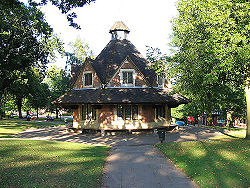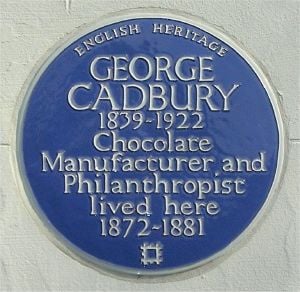George Cadbury
George Cadbury (September 19, 1839 – October 24, 1922) was the third son of Quaker John Cadbury, the founder of Cadbury's cocoa and chocolate company, a social reformer and philanthropist. George is best known for building decent housing for his employees and for establishing what has been described as a private social security program for their benefit. Through ownership of several newspapers, Cadbury promoted his ideas about welfare, promoting the concept of an old age pension and improvement of working conditions. Through charities and trusts established by members of the Cadbury family they are as well known for their philanthropy and humanitarianism as they are for the successful business they founded. An enthusiast of adult education, Cadbury also taught at the Birmingham Adult School. After World War I he left the Liberal Party, which he had supported, and was a co-founder of an anti-war movement, the Union of Democratic Control alongside, among others, Ramsay MacDonald, Britain's first Labour Prime Minister.
Biography
George Cadbury was born in Edgbaston, Birmingham, where his father John was a tea and coffee merchant. George was a pupil at the Quaker School. His family were committed members of the Society of Friends. Following his mother's death in 1855, George and his brother Richard took control of their father's business since he was too ill to continue to manage it. At the time, the business was failing. The two brothers introduced powdered cocoa to their customers, and the business began to make a profit. From an early age, George decided that he wanted to place the welfare of his workers before anything else, and invest in the community that enabled his company to succeed. He believed that if workers enjoyed a happy homelife in attractive and sanitary surroundings, with a garden in which they could grow food, both they and the company would benefit from the esprit de corps that this would encourage. Together with his brother Richard Cadbury|Richard he took over the family business in 1861. In 1878 they acquired 14 acres (57,000 m²) of land in open country, four miles (6 km) south of Birmingham, where they opened a new factory in 1879. Over the following years more land was acquired and a model village, designed by architect William Alexander Harvey, was built to provide low cost houses for the workers. This village became known as Bournville.
Cadbury Ltd. prospered because of humanitarian working conditions. In the Bourneville factory, named after the local river and the French language|French word for town, they produced chocolate from 1879. The brothers cared for their employees; they both believed in the social rights of the workers and hence they installed canteens and sport grounds. Nineteen years after Richard died, George opened a works committee for each gender which discussed proposals for improving the firm. He also pressed ahead with other ideas, like an annuity, a deposit account and education facilities for every employee.
Cadbury donated the Lickey Hills Country Park to the people of Birmingham.

Bibliography
- Bennett, Leonie The Life of George Cadbury, Oxford: Heinemann Library, 2005 ISBN 9780431181059
- gardiner, A. G Life of George Cadbury, London: Cassell, 1923
- Stranz, Walter George Cadbury Aylesbury: Shire Publications, 1973 ISBN 0852632363
External link
- Cadbury at City of Birmingham official site retrieved 14-04-2007
- Birmingham UK: George Cadbury Biography retrieved 14-04-2007
- George Cadbury at Brittanica online retrieved 14-04-2007
- Cadbury at the Bournville Village Trust site retrieved 14-04-2007
Template:UK-business-bio-stub
Credits
New World Encyclopedia writers and editors rewrote and completed the Wikipedia article in accordance with New World Encyclopedia standards. This article abides by terms of the Creative Commons CC-by-sa 3.0 License (CC-by-sa), which may be used and disseminated with proper attribution. Credit is due under the terms of this license that can reference both the New World Encyclopedia contributors and the selfless volunteer contributors of the Wikimedia Foundation. To cite this article click here for a list of acceptable citing formats.The history of earlier contributions by wikipedians is accessible to researchers here:
The history of this article since it was imported to New World Encyclopedia:
Note: Some restrictions may apply to use of individual images which are separately licensed.
